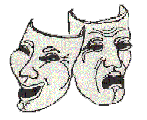Meet Pavlov's Dog

Most of us know the story of the famous experiment Pavlov
conducted with his dog, where he rang a bell each time before
he fed his dog. Soon, the dog linked the sound of the bell
with eating and would salivate simply at the sound of a bell
- even when no food was present!
Emotional responses can also be conditioned, and sometimes
we can even be emotionally conditioned from just one life
experience, especially if it was a traumatic event.
Similar But Different
Pavlov discovered something else. If a dog is conditioned
to salivate at the sound of a bell, the bell can be changed
to another bell that sounds slightly different and the dog
will still salivate. The same thing can happen with our conditioned
emotional responses. . . . . 
For example. A little boy is simultaneously scolded and spanked
by his father. This incident not only causes physical pain,
but also great fear. He gets an upset stomach and cries himself
to sleep. This is considered a natural response. However,
due to an imbalance in his body that does not allow him to
fully return to normal, he can now be triggered in the future
by a similar event. Today, as an adult, he finds himself becoming
overly tense and gets upset whenever an older man criticizes
him. He doesn't consciously connect the two incidents, and
can't figure out why he feels ill.
Where Do You Keep Your Emotions?
Scientists recognize the connection between the nervous system,
emotions, and health. Historically, emotions were thought
to reside entirely in the brain. Now we know other parts of
the body hold emotions too. If you've ever felt butterflies
in your stomach, or referred to something as a "pain in the
neck," or encountered someone who was "heartbroken" or who
"vented their spleen," then you're familiar with how parts
of the body can be linked to our emotions.
Dreaming Without Sleeping
Even imagined events can stimulate a response
and have a dramatic effect on how our body works. Have you
ever awakened in the middle of the night in a pool of sweat
with your heart racing after a disturbing dream? Fortunately,
the attacker wasn't real, but your body thought he was! Of
course, we're more conscious of this process when we have
to give a speech, ask the boss for a raise, suffer the loss
of a loved one, or experience other negatively-charged emotional
events.
Finding the Emotional
Short Circuit
The "emotional baggage" associated with past events in our
lives (remember Pavlov's dog?) can sometimes haunt us for
years. Like a computer "bug," unresolved negative associations
are stored in our bodies, often short-circuiting our true
desires; even our health. NET practitioners can help you identify
and "let go" of a stuck emotional event (real or imagined)
that is locked in a particular part of your body. The wonderful
result can be a new level of health and confidence.
|
Finding the Emotional
Short Circuit
The "emotional baggage" associated with past events in our
lives (remember Pavlov's dog?) can sometimes haunt us for
years. Like a computer "bug," unresolved negative associations
are stored in our bodies, often short-circuiting our true
desires; even our health. NET practitioners can help you identify
and "let go" of a stuck emotional event (real or imagined)
that is locked in a particular part of your body. The wonderful
result can be a new level of health and confidence.
A Simple Test
Just as static electricity can make your hair stand on end,
certain parts of your body can become "charged" with an emotional
memory. Finding and balancing these stuck memory loops can
be a lot of fun. By testing your muscle response, usually
using your arm, your practitioner can identify which nervous
system "circuit" in your body is holding the particular emotionally
charged memory.
Your Emotional Reality
Research has proven that muscle testing can be used to determine
whether or not your body is "in harmony" with a particular
concept or idea. When doing NET, it is important to note that
the muscle response is not confirming whether something is
really "true" or "false," nor is it producing a "yes" or "no"
answer. In fact, there are times when muscle testing will
reveal that your body is not "in harmony" with a fact you
know to be true! In NET, all memory events are considered
"EMOTIONAL REALITY," because they may or may not correspond
with actual or historic reality. NET is never used to make
claims as to what may have happened in the past. Likewise,
NET is never used to predict the future or make a recommendation
of action for the future.
Your Memory and Your Body
To assist your NET practitioner in the correction,
you'll be asked to form a mental picture, or "snapshot," of
the original triggering event. Science has proven that when
you actively recall a remembered past event, your body chemistry
will respond in a way that is similar to how it responded
then. Visualize a lemon . . . go ahead . . . try it. Now,
think about cutting into the lemon. See the juice squirting
out. Now, take a bite of the lemon. Is your mouth watering?
If you're like most people, it is, and what you're experiencing
is a body response to the memory of a lemon. Our emotions
work the same way. Making the Correcting When you recall the
mental picture of the triggering event, your body will respond
in a way that is similar to way it originally responded. Your
practitioner will contact, or ask you to contact, a specific
body point, which will help your body "let go" of the stuck
emotional event. It's really that simple. You're Always in
Control After the correction many patients report feeling
that a burden has been lifted from their shoulders. Normally
the procedure is a very simple and comfortable. If it becomes
too personal or uncomfortable, simply tell your practitioner.
A different approach may be suggested or, if you prefer, the
session can safely end. Patients enjoy the fact that they
are always in control.
|





